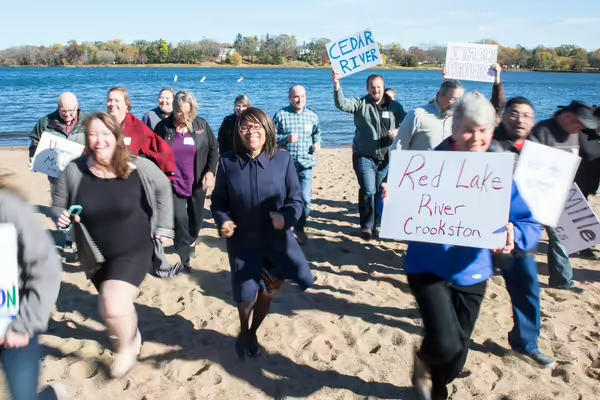
URBANA, Ill. – Achieving clean water goals requires the inclusion of diverse views and considering the equity of impacts and solutions; yet, underrepresented communities don’t always have a voice in watershed planning efforts.
At a symposium as part of a 2022 Climate Intersections Conference, watershed professionals examined ways they could advance diversity, equity, and inclusion in their community-based work. Five practical takeaways arose out of their discussion.
Don’t forget about the people
Watershed professionals care about water and the environment and use science and data to identify problems and measure success. With this focus, it can be easy to forget that watershed projects take place in communities of people, often who also care about the local natural resources but haven’t historically had a voice in the decision-making.
The Carlton Soil and Water Conservation District uses social data, such as the Social Vulnerability Index, to identify populations in local watersheds that have been historically overlooked in the watershed planning process, says Melanie Bomier, assistant manager of Carlton Soil and Water Conservation District and symposium panelist.
Organizations must then take the extra step of going to the people: building relationships, listening to their needs, and understanding their perspectives to ensure inclusive goals that align with those of the people who live there.
“Underserved populations may have priorities, values, and knowledge that haven’t yet been considered but can enrich watershed work and ensure everyone benefits,” says Lisa Merrifield, University of Illinois Extension community and economic development specialist and symposium co-organizer.
Build trust and relationships
“If you want to go fast, go alone. If you want to go far, go together.”
Andrea Crouse, another panelist and community development manager at Zeitgeist Arts, says relationship building is a skill, and doing it well takes time and commitment to the process.
Crouse and the other panelists remarked that it also takes reciprocity, or a mutually beneficial exchange. Listening, learning, and building trust need to come first, before presenting project needs, especially when working in a community that has been marginalized.”
Building trust requires flexibility, transparency, and patience.
“If, through listening, you realize that your project won’t actually help local communities, despite your best intentions, be ready to adjust,” Merrifield says. While project and grant deadlines can be constraints to relationship building, they should not be the drivers of building connection.
By factoring in the time necessary to show up and be consistent long before diving into projects, authentic engagement can help watershed professionals and the communities they serve lay a foundation of respect and cooperation that can lead to trust that the work proposed will help the community in the long run.
Listen to what people need
“Listen with the ear of your heart,” says Jennifer Niemi, the third symposium panelist and director of Native Studies at College of St. Scholastic. By listening deeply, with a willingness to receive new information from diverse perspectives, it ensures equitable and inclusive participation and outcomes.
Listening goes hand-in-hand with building trust.
“In watershed work, it is critical that all voices are heard, listened to, and respected,” says Jenny Seifert, symposium co-organizer and watershed outreach specialist at University of Wisconsin-Madison Division of Extension. Through listening, it may become clear that, while community members have different perspectives, values, or priorities, they can still get to the same goal.
“Listening allows you to reassess, revisit, and pivot as necessary to ensure you are meeting the diverse needs of the people in your watershed,” Seifert says.
Foster diverse leadership
Even after identifying underserved populations, building trust, and listening, it is important to empower and provide opportunities for people in those communities to participate in leadership roles.
For example, Crouse describes a community liaison program that Zeitgeist Arts implemented to advance a local health initiative in an underserved neighborhood of Duluth. They hired community members to serve on a steering team, gather input from neighbors, and help shape the strategy that would have buy-in from residents, thereby also building local capacity and leadership.
Leadership structures must fit the community. This might include providing training or continuing education. It might also require creating paid positions with clear objectives to legitimize the leadership roles. Regardless, it requires a commitment to learn from the people in the community what would make serving as leaders rewarding and valuable to them.
Consider the logistics of inclusion
The logistics of life, such as scheduling and childcare, can often be barriers to participation. A practical way to increase opportunities for inclusive engagement is to remove those barriers.
Providing food, transportation, and childcare can make it easier for people to participate. Understanding the differences in people’s daily or seasonal rhythms can help minimize scheduling pains. Addressing these barriers requires more flexibility in grant funding that aren’t always permitted by the funder. Additionally, resources need to be applied to developing multi-language resources.
Creativity can go a long way in reaching beyond the usual audiences. For example, one municipality invited community members to write love letters to their parks to learn what people value about them.
Writer/Source: Lisa Merrifield, Sustainable Community Specialist, University of Illinois Extension
Writer/Source: Jenny Seifert, Watershed Outreach Specialist, University of Wisconsin-Madison Extension
Writer/Source: Anne Sawyer, Water Resource Educator, University of Minnesota Extension
This piece was adapted from a blog originally posted on the Confluence of Watershed Leaders Human Capital Blog
Image credit: Minnesota Pollution Control Agency, We Are Water MN
Illinois Extension leads public outreach for University of Illinois by translating research into action plans that allow Illinois families, businesses, and community leaders to solve problems, make informed decisions, and adapt to changes and opportunities.